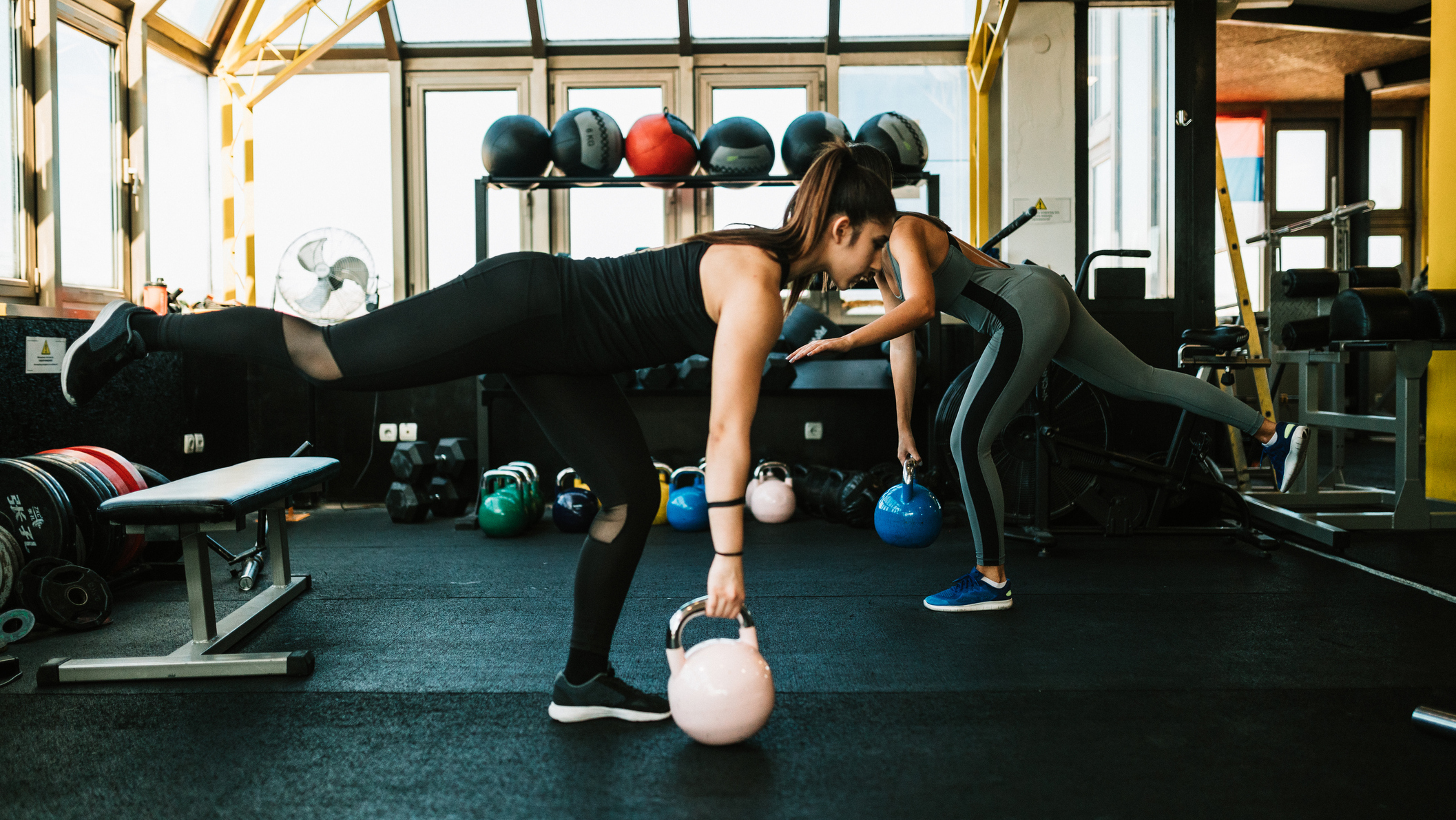How To Do The Single-Leg Romanian Deadlift With Perfect Form
Strengthen your posterior chain and prevent common sports injuries by learning the correct form for the single-leg Romanian deadlift

The standard deadlift and Romanian deadlift are superb leg exercises that build strength along the full length of your posterior chain, from your hamstrings and glutes to your lower back. But once these moves are perfected, it’s worth layering on a single-leg variation to develop your lower-body strength in a more functional, sports-specific way.
Step forward the single-leg Romanian deadlift (or single-leg RDL for short). Whether performed with just your bodyweight or loaded with a dumbbell, kettlebell or barbell, it’s a challenging, technical exercise that will boost your coordination and balance, while evening out any imbalances of strength between your left and right side.
To drill down into all the dos and don’ts of this tricky exercise, and provide regressions and progressions to suit all levels, we spoke to Waz Ashayer, trainer at fitness app Fiit and group fitness manager at Equinox, NYC.
What is the single-leg Romanian deadlift good for?
Ashayer is a big advocate of the single-leg RDL. “It’s a fantastic move to strengthen the hamstrings in a lengthened position while creating a high stability demand that builds resilience,” says Ashayer, adding that this translates very well to sport, making it an essential exercise for anyone with athletic aspirations.
The single-leg RDL is especially useful for runners—or any sport that involves running for that matter—as working one side of your body at a time will improve the stability in your ankles, knees and hips, helping to make you more resistant to injury.
What’s more, your core will be working overtime during the exercise to resist rotation and help keep your balance, so your abs and lower back will be getting a good workout too.
How To Do The Single-Leg Romanian Deadlift
Here we will describe how to do the exercise with a barbell, but it can also be done with a dumbbell or kettlebell in each hand or just one, or without any weight at all. It’s certainly worth trying the bodyweight version first to get used to the movement and improve your balance. Doing the move with just your bodyweight is also ideal as a warm-up to prime the muscles before adding weight. Of course, whichever type of free weight you end up using, you’ll want to use far less weight than you would lift in the standard deadlift or Romanian deadlift when you have both legs planted on the ground.
The Set-up
To start, hold a barbell by your thighs with an overhand grip and your hands shoulder-width apart. “The single-leg RDL is a hip-dominant exercise so every inch of the movement should be steered by your hips shifting back,” says Ashayer, rather than by allowing the weight to pull you forward.
Begin with your feet together, keeping the bar tight to your thighs and close to your center of gravity throughout to minimize any strain on in your lower back. Maintain a slight bend in your knees, move your shoulder blades back and down, and take a deep breath to brace your core.
The Hinge
To initiate the movement, think about lifting one leg high behind you. This will naturally trigger you to hinge forward at the hips. Focus on keeping your back flat, letting your eyes look down to the floor as you move through the exercise to keep your neck in a neutral position.
It’s vital to keep your hips level, rather than letting them twist or rotate. To help resist this rotation, Ashayer suggests thinking about keeping your shoulders square to the floor throughout, which will help your hips follow suit.
You should feel tension in the hamstrings of your standing leg as you lower the bar. Only lower it as far as you can—such as to just below the knees—while maintaining a flat back.
The Return
From this lowest position, reverse the movement by bringing your hips forward to standing, exhaling as you go. You can maintain a slight bend in your standing leg but try to keep it relatively straight to work the full length of your hamstrings.
“Concentrate on keeping your center of gravity directly through the middle of your standing foot so that you push off the ground evenly,” says Ashayer.
Immediately continue into the next rep, maintaining tension in the back of the thighs and glutes of your standing leg.
Common Single-Leg Romanian Deadlift Mistakes
Due to its complexity, the single-leg RDL can be a tricky move to get right. Here are some of the most common mistakes Ashayer sees creeping in for both novices and experienced gym-goers.
Rotating Your Hips
Losing your balance is a telltale sign that the hips have shifted out of position and your bodyweight is lopsided. Ashayer has three easy fixes.
First, practice this exercise in a B-stance stance, with the toe of your back foot in contact with the floor throughout—also known as a kickstand RDL, a variation that’s detailed below.
Sign up for workout ideas, training advice, reviews of the latest gear and more.
Second, perform as in the form guide above but hold onto a support, like a low bench.
Third, lower or ditch the weight and focus on keeping your core rigid to solidify your stability.
Holding Your Neck In An Unnatural Position
Craning your neck to look forward is another common error that can afflict all deadlift practitioners, likely to keep an eye on their form in the weights room mirror. Rather than looking forward throughout, keep your neck neutral, allowing your gaze to track with your movement. If you must check your form, record a few reps with your phone and watch it back to see where you can improve.
Rounding Your Back
“If you’re unfamiliar with the technique required to load a deadlift through the hips and posterior chain, a common side effect is a rounding of the spine,” says Ashayer. This puts undue pressure on the lower back and negates the focus of the move. To fix this, he says, remember to keep your back locked in position from your hips to your shoulders, pivoting only from the hips.
Single-Leg Romanian Deadlift Variations, Progressions And Regressions
Few exercises will mimic the unilateral demands of the single-leg RDL, but if you find this version altogether too challenging, even when using just your bodyweight, Ashayer recommends two things.
Work on your bilateral posterior chain strength with the regular Romanian deadlift, and unilateral glute and hamstring strength with the kickstand RDL, single-leg glute bridge or single-leg gym ball hamstring curl. Once you’re ready to step it up a notch, a staggered stance kettlebell swing or snatch are his go-to progressions to train power and speed in the same movement.
Romanian deadlift
Stand with your feet hip-width apart, holding a barbell in front of you with your hands shoulder-width apart. Keeping your back straight throughout, move your shoulder blades back and down, take a deep breath to brace your core, then sit your hips back to lower the bar down your thighs to just above or below your knees, depending on your flexibility. You should feel a deep stretch in your hamstrings at this point. Pause, then press the floor away and drive your hips forward as you exhale to stand tall. Pause, squeeze your glutes hard, then repeat.
Kickstand Romanian deadlift
Adopt an off-set stance by stepping one foot slightly behind the other, keeping your front foot flat on the floor and your rear foot on its toes. Your weight should be in your front leg. Maintain a slight bend in your front knee, holding a dumbbell or kettlebell in the hand on the opposite side to your leading leg, then push your hips back to lower the weight. Perform all the reps on one side, then switch sides.
Single-leg glute bridge
Lie on your back with one knee bent and foot flat on the floor, and the other leg straight, raised off the floor, with your knees aligned. Press your lower back into the floor, then drive your hips up as high as you can, squeezing your glutes hard. Pause, then lower to tap the floor and repeat. Perform all the reps on one side, then switch sides. This move can also be performed with your feet elevated on a low box or bench for a greater challenge.
Single-leg gym ball hamstring curl
Lie on your back with your arms resting on the floor at the sides and your knees bent and heels resting on top of a gym ball. Lift your hips off the floor so your weight is supported by the ball and your upper back. Extend your legs to roll the ball away from you, then lift one heel off the ball, keeping that leg extended while you bend the knee of your other leg to roll the gym ball towards you. You should feel this targeting the hamstring of your bent leg. Extend your leg fully, rolling the gym ball away while keeping the other leg elevated, and repeat.Perform all the reps on one side, then switch sides.
Staggered stance snatch
Adopt an off-set stance by stepping one foot slightly behind the other, keeping your front foot flat on the floor and your rear foot on its toes. Your weight should be in your front leg. Maintain a slight bend in your front knee, holding a dumbbell or kettlebell in the hand on the opposite side to your leading leg. Push your hips back to lower the weight, then drive your hips forward with power to generate momentum to begin lift the weight. As the weight passes your hips shrug the weight up and as it passes your shoulder punch the weight straight up and extend your arm overhead. Carefully return the weight to the start and repeat. Perform all reps on one side, then switch.
About Our Expert
Wassim “Waz” Ashayer is a trainer at fitness app Fiit and group fitness manager at Equinox NYC. Originally from London and now based in New York City, he is one of the industry’s most sought-after PTs and recently co-founded pop-up fitness brand Raise x Take Off. Ashayer has a series of qualifications from the National Academy of Sports Medicine (NASM) including Kettlebells, Group Fitness Training, Circuit Training and a Diploma in Personal Training. He is also a certified TRX trainer.

Sam Rider is an experienced freelance journalist, specialising in health, fitness and wellness. For over a decade he's reported on Olympic Games, CrossFit Games and World Cups, and quizzed luminaries of elite sport, nutrition and strength and conditioning. Sam is also a REPS level 3 qualified personal trainer, online coach and founder of Your Daily Fix. Sam is also Coach’s designated reviewer of massage guns and fitness mirrors.
- Nick Harris-FrySenior writer
